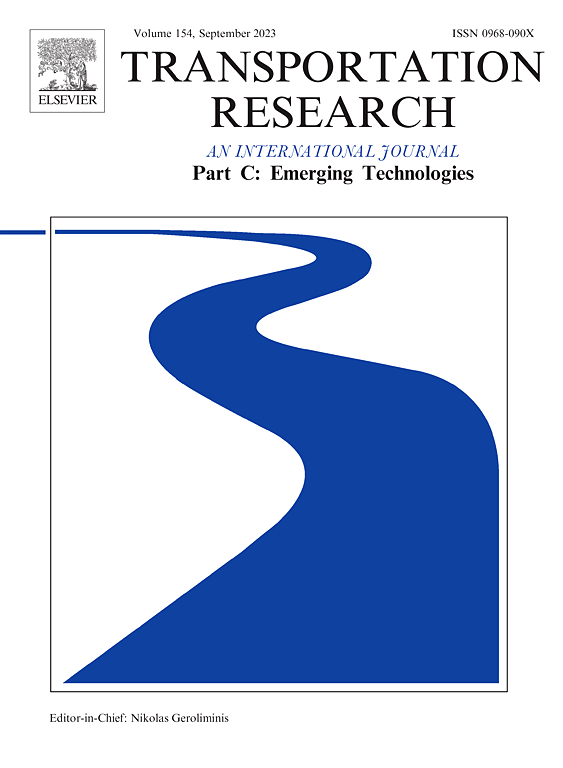Abnormal metro passenger demand is predictable from alighting and boarding correlation
IF 7.6
1区 工程技术
Q1 TRANSPORTATION SCIENCE & TECHNOLOGY
Transportation Research Part C-Emerging Technologies
Pub Date : 2025-06-28
DOI:10.1016/j.trc.2025.105239
引用次数: 0
Abstract
Irregular sudden fluctuations in metro passenger demand during events or incidents can lead to critical supply or safety issues. Accurate and timely forecasting of such abnormal demand is crucial for effective crowd management and emergency response. However, this task remains challenging due to the absence of periodicity, high volatility, scarce samples, and the need for early warnings. This paper addresses abnormal metro passenger demand forecasting by leveraging the long-range Alighting-Boarding (AB) correlation driven by chained travel behavior. We propose a novel Alighting-Boarding Transformer (ABTransformer) model to explicitly capture the AB correlation with an interpretable bi-channel attention mechanism. Using real-world metro datasets from Guangzhou and Seoul, we demonstrate that leveraging the AB correlation significantly reduces the mean absolute error (MAE) over a six-hour forecast horizon by 5%–17% across three representative models. The ABTransformer performs best in forecasting abnormal metro boarding demand and remains competitive in normal demand forecasting. Notably, leveraging the AB correlation enables early warnings of abnormal demand with up to a 5-hour lead time (depending on the activity duration), offering an effective abnormal demand warning solution that does not rely on auxiliary event data. Additionally, we investigate uncertainty quantification in demand forecasting with different distribution assumptions. We observe multimodality in forecast distributions and find that simpler distributions, such as the zero-truncated Gaussian, tend to be more robust than complex mixture models in abnormal demand forecasting when observations are sparse. Our findings indicate that joint forecasting of alighting and boarding is always preferred over independent forecasting in metro passenger demand forecasting, particularly for abnormal demand scenarios.
利用地铁上下车的相关性预测地铁乘客异常需求
在活动或事故期间,地铁乘客需求的不规则突然波动可能导致关键的供应或安全问题。准确、及时地预测这种异常需求对于有效的人群管理和应急响应至关重要。然而,由于缺乏周期性、高波动性、样本稀缺以及需要早期预警,这项任务仍然具有挑战性。本文利用链式出行行为驱动下的长时间下客-上客(AB)相关性,对地铁异常客运需求进行预测。我们提出了一种新颖的下车-上车变压器(ABTransformer)模型,通过可解释的双通道注意机制明确捕获AB相关性。使用来自广州和首尔的真实地铁数据集,我们证明了在三个代表性模型中,利用AB相关性可以显着降低6小时预测范围内的平均绝对误差(MAE) 5%-17%。ABTransformer在预测异常地铁上车需求方面表现最好,在预测正常需求方面仍具有竞争力。值得注意的是,利用AB相关性可以在长达5小时的提前时间(取决于活动持续时间)内对异常需求进行早期预警,从而提供不依赖于辅助事件数据的有效异常需求预警解决方案。此外,我们还研究了不同分布假设下需求预测中的不确定性量化问题。我们观察了预测分布中的多模态,发现在观测值稀疏的异常需求预测中,较简单的分布(如零截尾高斯分布)往往比复杂的混合模型更具鲁棒性。研究结果表明,在地铁客运需求预测中,特别是在异常需求情景下,下车和上车的联合预测往往优于独立预测。
本文章由计算机程序翻译,如有差异,请以英文原文为准。
求助全文
约1分钟内获得全文
求助全文
来源期刊
CiteScore
15.80
自引率
12.00%
发文量
332
审稿时长
64 days
期刊介绍:
Transportation Research: Part C (TR_C) is dedicated to showcasing high-quality, scholarly research that delves into the development, applications, and implications of transportation systems and emerging technologies. Our focus lies not solely on individual technologies, but rather on their broader implications for the planning, design, operation, control, maintenance, and rehabilitation of transportation systems, services, and components. In essence, the intellectual core of the journal revolves around the transportation aspect rather than the technology itself. We actively encourage the integration of quantitative methods from diverse fields such as operations research, control systems, complex networks, computer science, and artificial intelligence. Join us in exploring the intersection of transportation systems and emerging technologies to drive innovation and progress in the field.

 求助内容:
求助内容: 应助结果提醒方式:
应助结果提醒方式:


